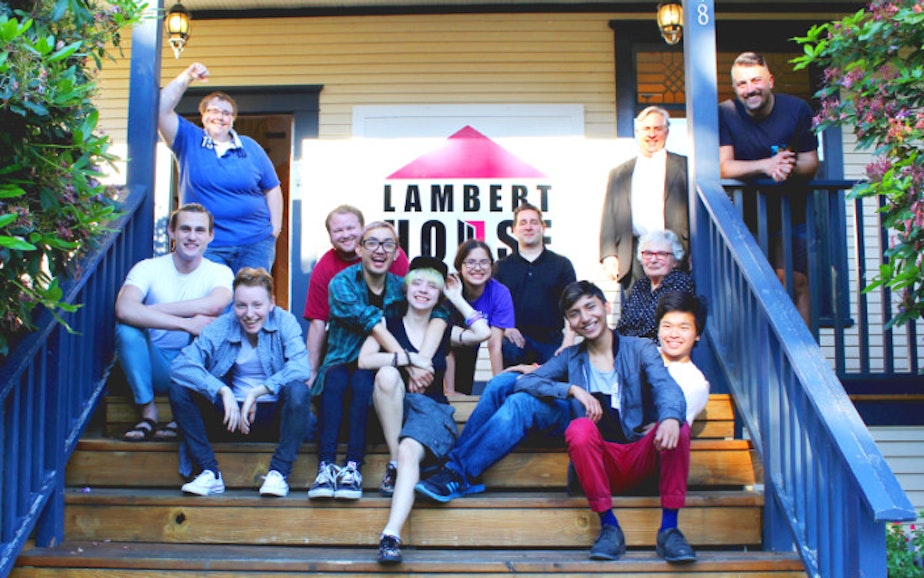How the Lambert House found a new life online during the pandemic

The Lambert House in Seattle's Capitol Hill neighborhood is a place where LGBTQ youth can find community, belonging, and support. It's been around for more than 30 years, but it shut down at the beginning of the Covid-19 pandemic.
During the pandemic, Lambert House found a new life online, and their programs reached more youth than ever before. RadioActive's Ada Walther went to the Lambert House, and met someone who found a home there.
[RadioActive Youth Media is KUOW's radio journalism and audio storytelling program for young people. This story was entirely youth-produced, from the writing to the audio editing.]
O
n a recent Friday evening at the Lambert House, teens eat dinner and play pool while adults hold lively conversations in the entryway.
The Lambert House is an old, two-story wooden house. The organization says it is one of the first nonprofits in the United States aimed exclusively at serving LGBTQ youth.
When I visited, the house was filled with people. But not long ago, it was empty. Like so many other organizations, the Lambert House stopped in-person programs at the start of the pandemic.
Sponsored
Koschei Budkar is a 20-year-old student at the University of Washington who has been a part of the Lambert House community since before the pandemic.
Koschei moved to Washington from Russia when he was 11 years old. Now he lives about 28 miles east of Seattle, in Snoqualmie. He wears glasses, and he grins and laughs while he answers my questions over a Zoom call. Behind him, I can see the foothills of the North Cascades.
As a kid, Koschei figured out that people could be queer through reading fanfiction. He has been exploring his identity ever since.
"I am queer," Koschei said. "Probably trans-masculine or nonbinary. Definitely aromantic and asexual. Maybe a bit pan. A bit hard to figure out sometimes."
Sponsored
In Russia, where Koschei is from, there is a ban on any action or information seen as an attempt to promote homosexuality. So, when Koschei started high school here in the U.S., he was eager to connect with others in the LGBTQ community.
"It just seemed like such a fun thing to be in a queer club," Koschei said. "Because, in Russia, you will not find a lot of them. Let's be honest."
But Koschei found his high school's Gender Sexuality Alliance club, or GSA, to be disorganized and clique-y.
"I felt like a bit of an outsider," he said.
I could empathize — I've found clubs for LGBTQ students at my high school to have the same problems.
Sponsored
Luckily, Koschei was introduced to the Lambert House when a speaker came to his school's GSA to advertise new meetings happening in Snoqualmie.
"Lambert House specifically is full of people with whom it is much easier for me to talk, and with whom I feel much more comfortable," Koschei said.
Brandon Knox, the program director at Lambert House, says most youth who come to Lambert House are looking for community.
"Of youth who come to the Lambert House, 92% tell us, 'Our number one goal is to make friends,'" Knox said. "And even the other 8%, usually their number two goal is to make friends."
But then, the pandemic happened. Lambert House had to try and move that community online.
Sponsored
Unexpectedly, youth started signing on from all over the country. Lambert House had online program participants from places like South Carolina, Georgia, Kentucky, Missouri, and Florida.
"We were all sort of shocked," Knox said. "These youth all lived in places where there was nothing like Lambert House before the pandemic. There's no GSA in their school, there's nothing in their community. And they were just so grateful to find something. And for us, it was amazing to make that social support available in places we hadn't anticipated."
The core mission of the Lambert House is to reduce isolation among LGBTQ youth. And Koschei said, without the Lambert House, he would have been much lonelier during the pandemic. This means Koschei's experience was a success, just like it was for the many others who relied on the Lambert House for connection and a sense of belonging.
This story was produced in a RadioActive Youth Media Advanced Producers workshop for high school and college-age youth. Production assistance by Jennifer Wing. Edited by Eilis O'Neill. Prepared for the web by Charlotte Engrav.



